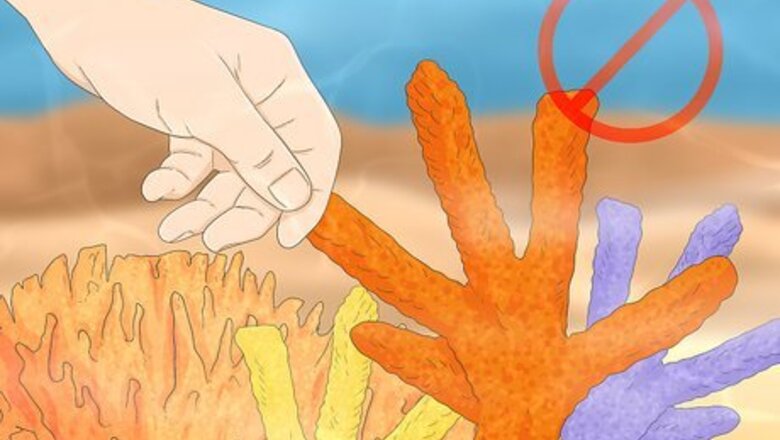
views
Being a Responsible Tourist
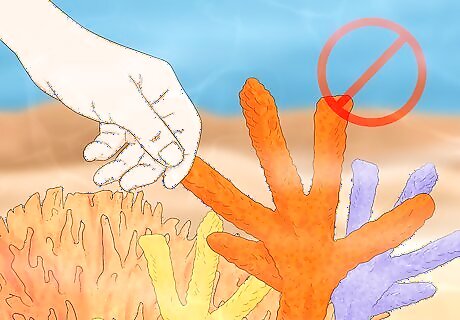
Avoid striking or touching a coral reef. Running your boat into a coral reef can cause it serious damage. Protecting coral reefs depends on what experts call proper "vessel management." Understand where coral reefs are so your boat doesn't strike them, even incidentally. People can also damage coral reefs simply by touching them. Corals on reefs are actually small animals. This living ecosystem is thus very fragile and susceptible to damage. The coral animals are not mobile. They live in colonies, and possess skeletons of hard calcium carbonate, which is what gives the coral reef its structure. Remember the feet. Control your flippers when diving or snorkeling so you don't accidentally touch a coral reef.
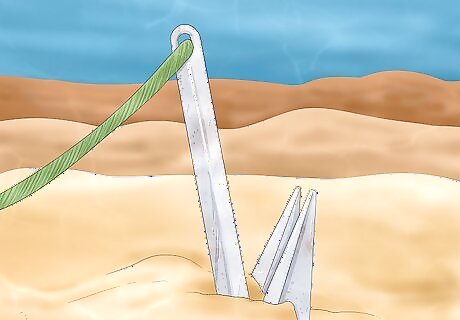
Don't fish or boat near a coral reef. Contact with things like anchors and fishing nets is a key way that coral reefs die or suffer damage. Do not anchor your boat on a coral reef. Instead, anchor your boat in an area with a sandy bottom or use a mooring. You could also use an installed buoy instead of an anchor. Fishing lines, nets, and fishing hooks all cause damage to coral reefs. This is just another reason why it's best to take your fishing elsewhere. Figure out where coral reefs are located before you venture into the ocean. Do not discharge wastewater from your boat into the ocean. Find an acceptable wastewater discharge facility in the area instead.
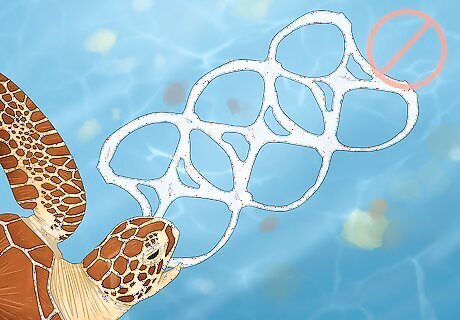
do not litter on the beach or in the ocean. Leaving behind things like fishing nets or general garbage on a beach can harm coral reefs. Throwing litter into the ocean itself can eventually cause the trash to come into contact with the coral reef. When trash ends up on a coral reef, it can actually smother the corals. Remember, they are living organisms. Sometimes people see corals as they see shells. However, corals are alive and, thus, they are very susceptible to harm. Littering can also cause harm or even kill the fish that populate coral reefs. The technical term for this kind of litter is "marine debris." Marine debris also damages other organisms on coral reefs that are necessary for their survival. Some organizations sponsor beach cleanups. If you help pick up other people's litter on beaches, in addition to not littering yourself, you will help coral reefs.
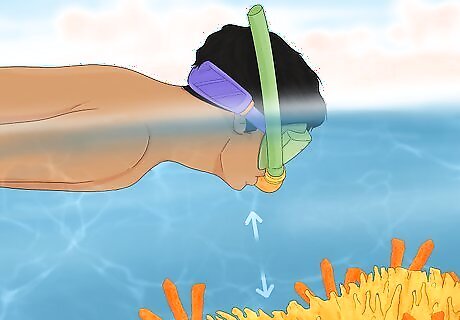
Snorkel and scuba dive with care. Many people enjoy snorkeling near coral reefs because of their unique beauty. Snorkelers and divers can cause serious damage to coral reefs, especially in areas with heavy tourism. Definitely do not pull a piece of coral reef off to take with you. They say you should leave only bubbles and take only pictures when you are in the ocean. Remember that you are destroying a living organism if you do take a piece of the reef. Practice snorkeling before you venture anywhere near a coral reef, so you don't come into accidental contact with it. Stay horizontal in the water and avoid kicking sand or flailing around with your fins. Don't swim too fast or use your arms when swimming. If you touch a coral reef, it can cause you harm, too. People have been cut and stung by coral reefs. Do not get close to a coral reef while wearing a lot of sunscreen. The oils from the lotion causes coral reefs damage.

Don't purchase coral souvenirs. You shouldn't take anything out of the ocean that's alive, or buy it in a store, either. In some countries, you will find jewelry and other souvenirs made out of coral. Don't buy them. It is illegal to sell coral in some countries. Coral can take a long time to grow, so taking it for your aquarium or jewelry box can have a lasting effect that will take years to undo. Red and pink coral is especially prized as jewelry because of its coloring. It comes from deeper waters. Don't purchase coral reef fish, either. Inquire about marine fish before you buy them in pet stores. You want fish that were bred in captivity.
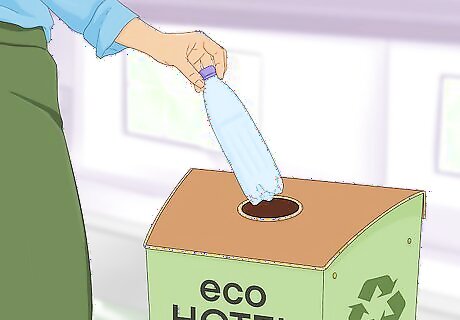
Choose a hotel that embraces environmentalism. Hotels can make a big impact on the environment. They are often close to shores, and a lot of people pass through them. Support hotels with policies designed to reduce pollution. Hotels that have programs to treat sewage and offer recycling and other sustainability measures can help protect coral reefs by improving the overall environment around them. Tourism associated with coral reefs is one of the fastest growing segments of the tourism industry, so it could make a big difference if more hotels are pressured by consumers to adopt sustainable practices.
Reducing Environmental Damage
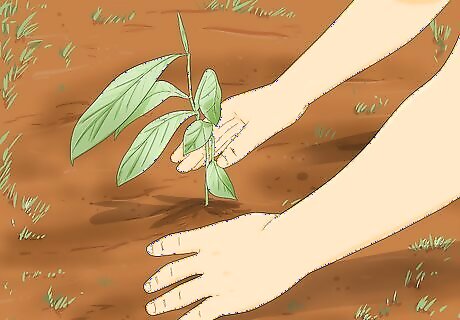
Practice general conservation. Coral reefs are damaged when the general environment around them declines. So, you can help protect coral reefs simply by leading a more sustainable lifestyle. Plant trees. Trees reduce runoff into oceans, and runoff can damage coral reefs. Reduce your carbon footprint. This really matters. Increasing carbon dioxide in the air can lead to global warming, which can harm coral reefs. It's all interconnected. Ways to reduce your carbon footprint include biking to work and using a clothes line. Use less water. This will help decrease runoff, which is a key way that coral reefs are harmed. Use organic fertilizer to avoid chemicals running into the ecosystem. Don't assume that chemicals in your garden or on your farm won't find their way back into the ocean just because you don't live near it.
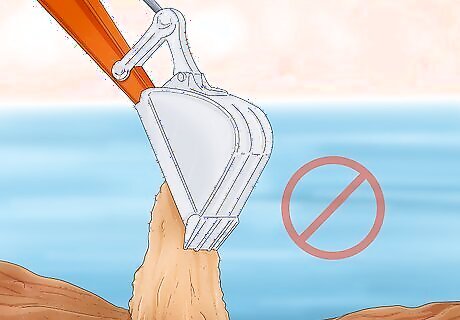
Avoid near shore development and construction. Some coral reefs are located near shores. They can be damaged by various aspects of land development and construction, including the building of marinas, docks, and plowing of fields. When sediment and silt loosen because of development and construction and end up in the ocean, this can block sunlight and cause corals to die because they need sunlight to thrive. Sediment can actually bury the corals, killing them or stopping them from growing completely. Metals, pesticide, herbicide and other chemicals associated with mining, and runoff from landfills, agricultural, and urban development projects can damage corals as well as the fish around them.
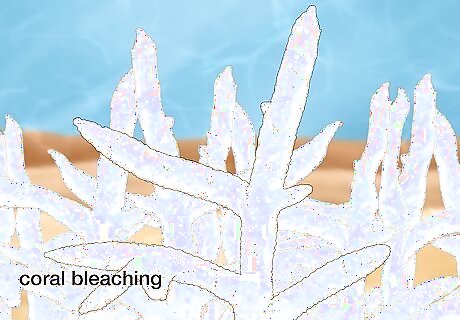
Oppose global warming. General worsening of the environment is an indirect way that people are causing harm to coral reefs. They are very sensitive to rising water temperatures, which cause them harm. Reducing your carbon footprint also helps stop global warming. As little as a one-degree rise in water temperature causes coral reef damage. Coral bleaching is a key indicator that coral reefs are unhealthy, and it's been increasing since the 1980s. Algae inside the reef provide its color, and bleaching of the coral occurs when algae are either missing or die. Warmer ocean temperatures can also spur the growth of algae that is harmful to coral reefs because it blocks the sun that they need to thrive. When oceans heat up, they have more carbon dioxide in them. This slows the growth of coral reefs by making it harder for corals to create calcium carbonate skeletons.
Helping Educate People about Coral Reefs
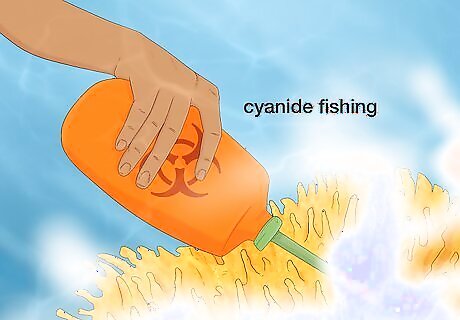
Boycott damaging fishing methods. If you consume fish caught in a way that damages coral reefs, you are part of the problem. Not using products obtained through damaging the environment is a way to help protect the reefs. Understand which fish are caught in a way that damages reefs, and spread the word. In some countries, people actually blow up coral reefs with explosives so they can more easily catch the fish that cluster around them. Then, they sell the fish to restaurants and stores. Another devastating fishing method involves putting cyanide into the water to stun fish. This kills the coral reefs around them. Overfishing is another way that damage is caused to coral reefs. There is economic pressure in some countries to fish in this manner because coral reefs can provide as much as one-quarter of the fish eaten in some developing countries. Don't eat fish caught with bottom trawling methods. Bottom trawling is so damaging that it can destroy reefs that could live for thousands more years and exist deep in the ocean. An example of a fish sometimes caught through bottom trawling is orange roughy.
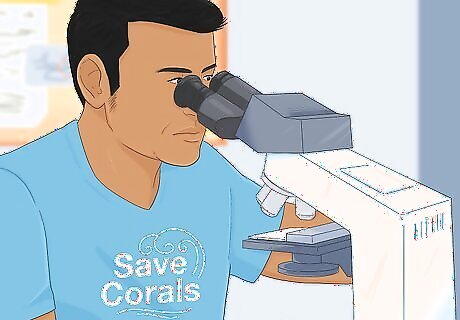
Volunteer to support reef science. Since 1998, the U.S. government has extensively mapped coral reefs to track their decline. The governmental efforts often link with private groups that accept donations and volunteers, as well as state and local efforts to protect reefs. Global efforts also exist to protect reefs. In Australia, the government has created ways for people to get involved to help protect the Great Barrier Reef. The government has created a monitoring program that allows average people to contribute to reef protection by reporting their own observations and data. Scientists study detailed maps that alert them to bleaching of coral reefs, which can be caused by rising sea temperatures and algal blooms. The data is so sophisticated that scientists receive updates every hour, focusing on coral reefs in Hawaii, Puerto Rico, and the U.S. Virgin Islands. They monitor barometric pressure, tide levels, air and water temperature, and other factors important to coral reefs. Scientists are breeding coral reefs and then testing different varieties in environments with greater acidity and other conditions. They have also found ways to plant corals in the ocean and to spur their growth by using electrical currents.
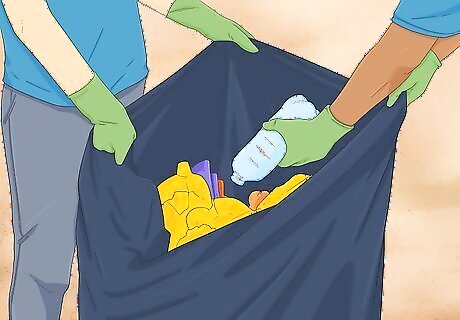
Help organizations dedicated to protecting coral reefs. There are many organizations that work hard to stop destruction of coral reefs. Some even build artificial reefs to replace destroyed or damaged coral reefs. The Coral Reef Alliance, Reef Relief, and Planetary Coral Reef Foundation are examples of private organizations trying to save coral reefs. The organizations, and others like them, offer numerous ways for people to get involved. You can sign up as a volunteer for a coral reef organization and become involved in events and education. Join a reef cleanup. Many of the organizations rely on donations. Some reef protection organizations have educational programs for children. Reef Relief offers a coral camp in Key West, Florida to educate children about the value of coral reefs.
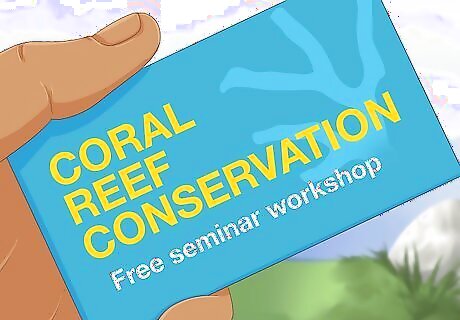
Tell others about coral reefs. Many people touch or otherwise harm coral reefs without intending to do so. They may simply not understand that reefs are full of fragile living creatures or realize that the smallest contact can cause them harm. Helping educate as many people as possible about coral reefs can make a difference. Many non-profit organizations devoted to reef protection offer extensive information about reefs on their websites. You can sign a pledge refusing to use coral jewelry. Governmental websites, such as the National Oceanic and Atmospheric Administration, offer detailed information about coral reefs, their importance, and protection. The National Fish and Wildlife Foundation, which was created by U.S. Congress, also works extensively on the issue. The Coral Reef Alliance urges people to educate others about the importance of reefs, and has free social media badges available that people can share to alert others to their support for protecting coral. They also offer e-cards.
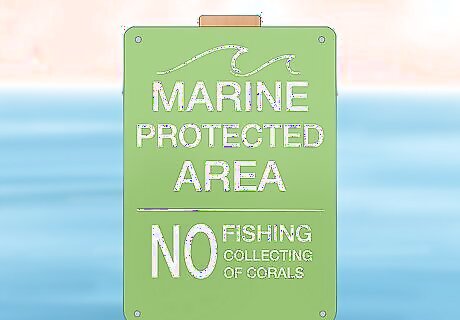
Pressure politicians to support reefs. Legal mechanisms that protect coral reefs can be critical. Let your politicians know that you want them to support measures that will ensure coral reefs suffer less damage. Creating marine protected areas is a measure that can make a difference. Read up on local action strategies so you understand what is already being done in your area and others. The U.S. Coral Reef Task Force develops federal and state strategies to protect coral reefs.


















Comments
0 comment